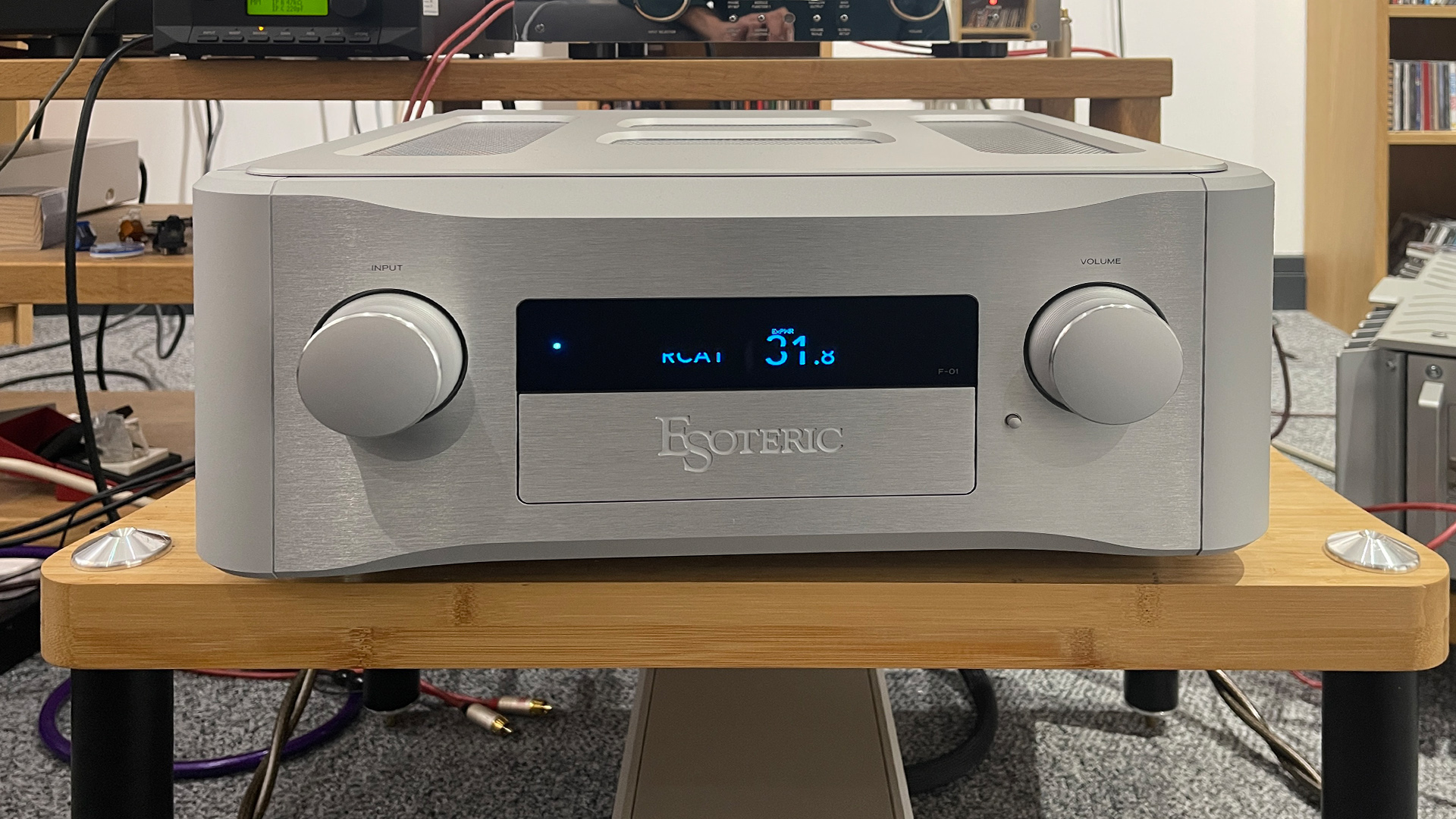What Hi-Fi? Verdict
Esoteric’s Class A F-01 amplifier may not be an obvious choice at this level given its modest power output but its many talents are unquestionable. In the right system, it is a stunning performer
Pros
- +
Excellent detail resolution and class-leading refinement
- +
Expressive dynamics
- +
Fine MM/MC phono stage
- +
Superb build
Cons
- -
Low power output means that it needs careful system matching to shine
Why you can trust What Hi-Fi?
If you are the kind of person who judges amplifiers on a power-per-pound basis, Esoteric’s range-topping F-01 integrated is in trouble. After all, when a 30-watt-per-channel integrated stereo amplifier costs much the same as a decent second-hand car, questions need to be asked. Fortunately for Esoteric, the F-01 has all the answers.
Why such a low output? The F-01 (£22,000 / $18,000 / AU$30,000) has a Class A circuit, and with that comes the promise of great sound quality and the curse of lots of heat. In such a design, the greater the power output, the more heat the amplifier will produce, so there is always a balance the engineers have to strike.
Esoteric configures the very similar F-02 integrated amplifier (£20,000 / $18,000 / AU$29,000) in Class A/B, and that has a claimed power output of 120 watts into an 8-ohm load and uses half the power at idle when doing so (110 watts vs 215 Watts for the F-01).
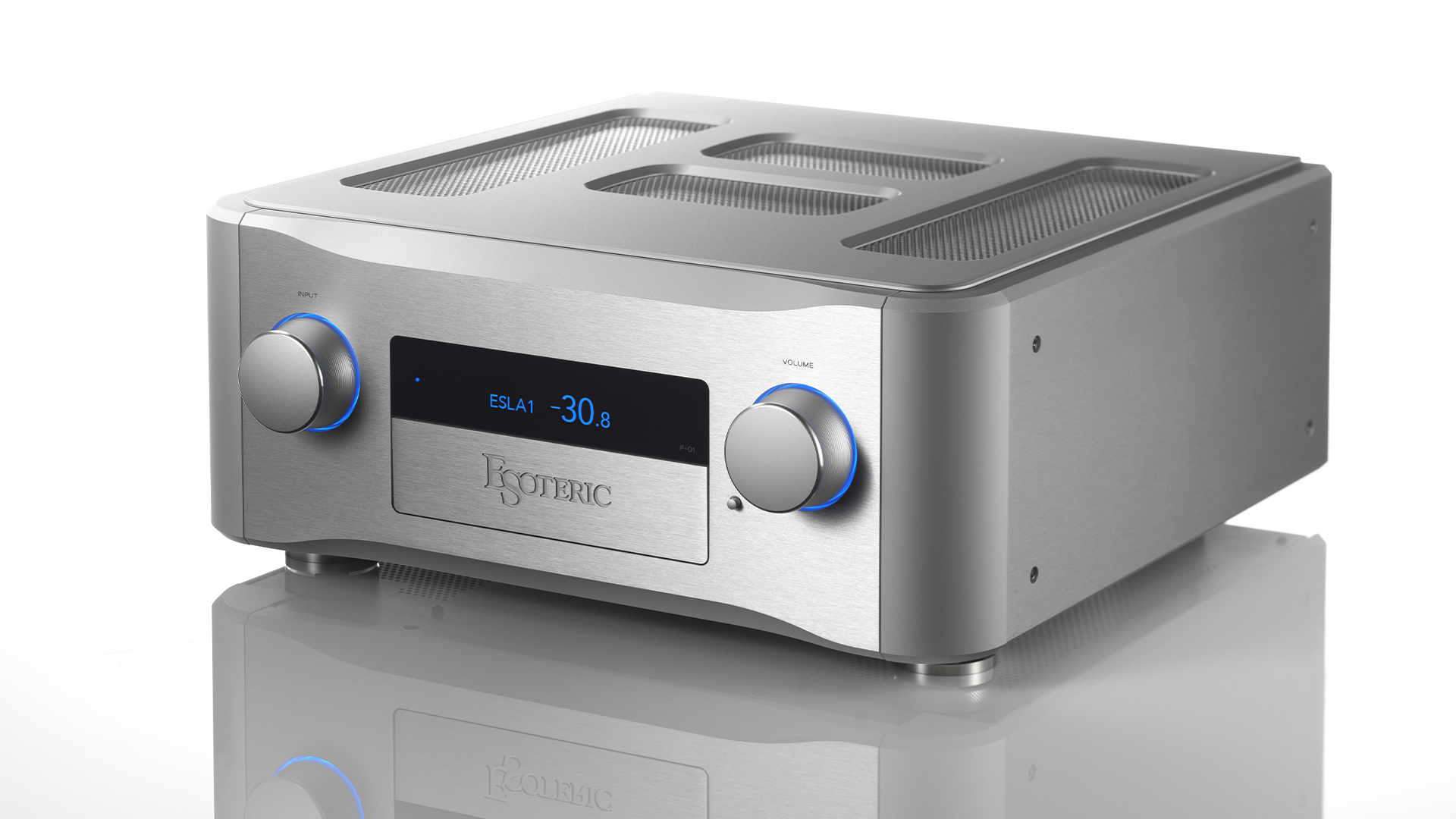
While integrated amplifier designs are usually seen as some sort of compromise compared with separate pre/power alternatives, given the price it is fair to assume that isn’t the case here. The F-01’s preamp circuitry design borrows heavily from the company’s range-topping two-box Grandioso C1X preamplifier (£47,500 / $46,000 / AU$59,500), which is a great starting point.
Aside from the usual embellishments we would expect from a product at this level, such as the use of top-grade components, generous power supply arrangements and carefully considered circuit layouts, the unusual thing here is that the F-01 preamp section operates with its voltage rails set far higher than in conventional designs. Such an approach is claimed to improve dynamics and the signal-to-noise ratio.
It has a dedicated feed from the power supply to minimise unwanted interactions between the various sections in the amplifier. While you would think that was the end of it, Esoteric has other ideas; the F-01 is upgradeable with the optional PS-01F outboard power supply (£5500 / $5000 / AU$9000), and we include it as part of this test.
The PS-01F takes the form of a modestly-sized box that connects to the integrated through a sensibly long umbilical and drives the preamplifier circuitry directly. The promise is of an even cleaner and stable power feed, though we find ourselves wondering just how effective it will prove when judged against the hefty outlay.
Design & engineering
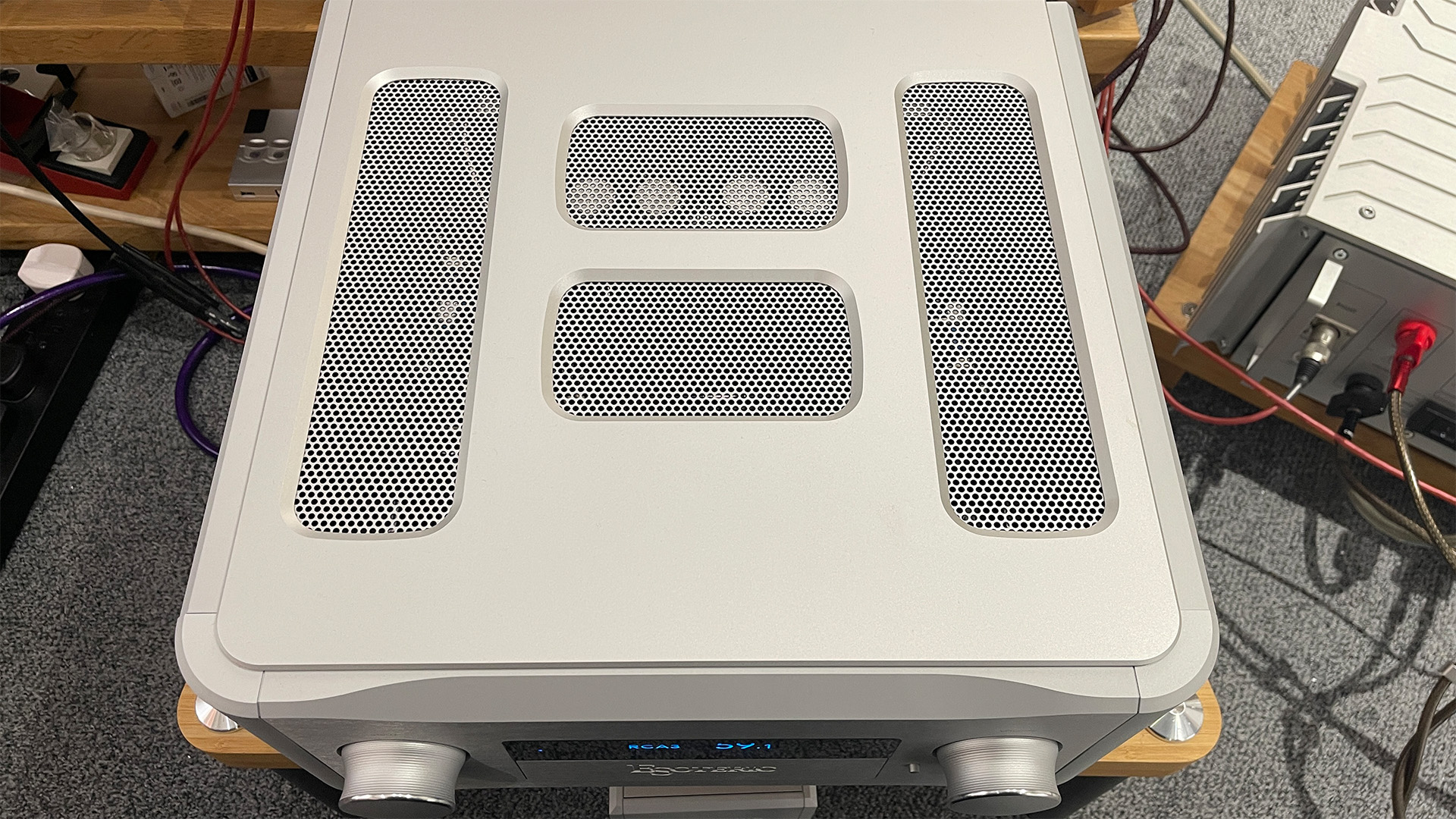
There is much to admire in the preamp’s design details. The volume control circuitry is a little special, being a stepped attenuator with a whopping 1120 0.1dB steps. All things being equal, stepped attenuators are usually thought to offer a more transparent sound than traditional potentiometers as well as a superior, more equal channel balance as volume levels drop. The usual drawback is a lack of subtlety in level adjustment at low volume settings, but given the huge number of steps the F-01 has, that really shouldn’t be an issue.
A great deal of care has been taken to minimise noise and distortion levels in the preamp section, from the use of FET element input switches rather than conventional mechanical relays to the logic circuitry interacting with the sensitive audio sections through a photocoupler to reduce unwanted interactions.
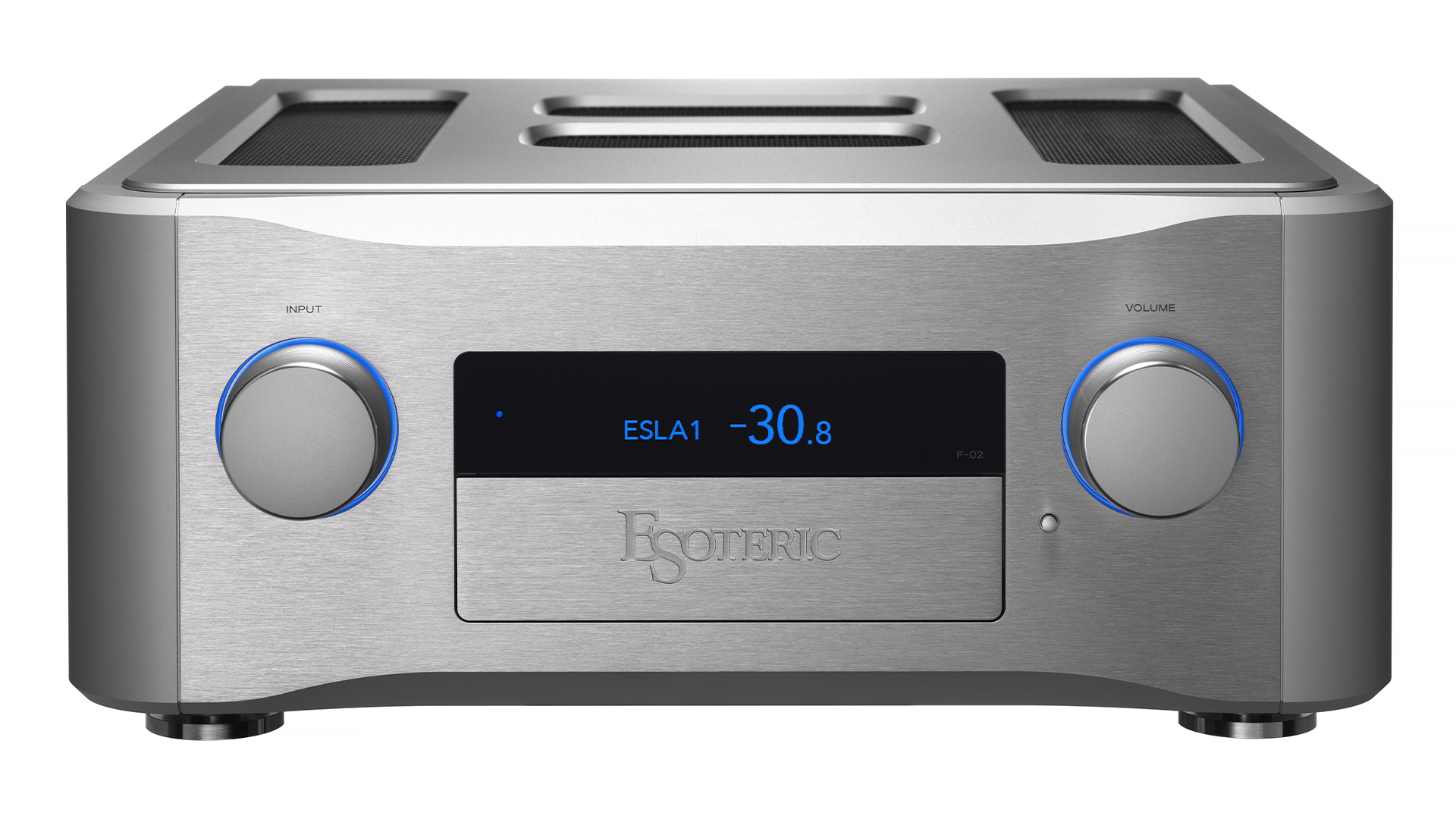
Type Integrated
Power 30W per channel
Phono stage? Yes (MM/MC)
Inputs Balanced XLR/ES-Link x 3, RCA x 3
Outputs Pre-out (Balanced XLR/ES-Link)
Bluetooth? No
Headphone output? Yes (6.3mm)
Dimensions (hwd) 19.1 x 44.5 x 47.1cm
Weight 32.2kg
We are pleased to find that Esoteric has included a switchable moving magnet/moving coil phono stage. It has a dual mono layout to optimise stereo imaging and has dedicated power supplies for each channel. While there isn’t the flexibility here that a dedicated high-end phono stage would offer in terms of cartridge loading options, we think Esoteric has chosen a sensible middle ground that will suit all but the most left-field of cartridge choices.
The F-01’s power amplifier section is built around a huge 940VA EI Core mains transformer. This is much larger than needed for the modest 30 watts per channel output to ensure that the amplifier has the capacity to deliver large dynamic swings without stress. The audio circuit is deliberately kept simple, being a bipolar transistor 3-parallel push-pull design where the negative feedback is kept to a minimum to optimise dynamic behaviour.
This is a Class A design and so produces lots of heat, but the engineers have provided enough in the way of heatsinking to prevent the casework from getting uncomfortably hot, as it can in similarly configured amplifiers we’ve come across. Even so, this integrated still needs to be placed where there is plenty of ventilation to avoid heat build-up becoming an issue. Also, at over 32kg the F-01 demands a sturdy support.
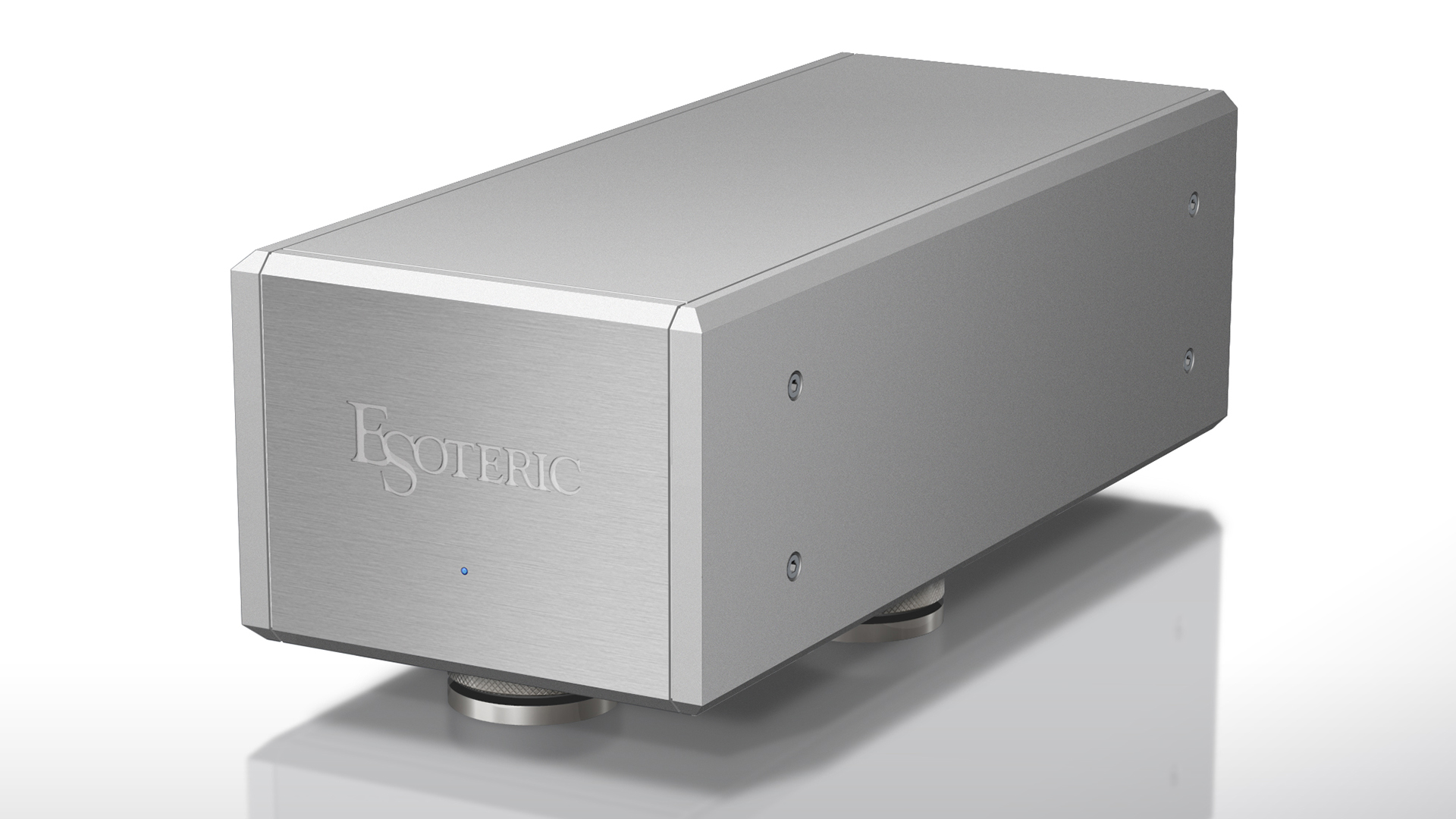
The F-01’s chassis is hardly ordinary. With two rather obvious exceptions, its casework feels immensely solid and inert while oozing reassurance that your money has been well spent. The first exception is that the top panel floats. It is essentially free to move a millimetre or so and rattles when we tap it. This is a little off-putting at first but shows that Esoteric isn’t afraid to think outside the box to optimise sound quality. The engineers found that loosely mounting the lid in this way leads to more openness to the amplifier’s sonic presentation, and so the ‘feature’ made it into production. The second is the feet. These are intricately designed and claim to isolate the unit from vibrations. You will think they are loose when lifting the F-01 from its packaging, but they make solid contact with the supporting surface once the amplifier is in place. Finish options? The only choice is silver.
The F-01’s fit and finish are exceptional, just as we would expect at this level, with every button and dial working with a slickness that shouts quality. We love the smooth way the twin rotary controls – input and volume – turn, and the distinct lack of play or wobble they exhibit. This reinforces the amplifier’s already strong aura of luxury.
Push a small button on the front panel and a metal flap drops to reveal a pair of headphone outputs (a 6.3mm and balanced 4-pin XLR) along with buttons to set the amplifier’s output (speakers or headphones) and access the set-up menus.
The set-up options cover all the usual things from setting individual input gain, accessing the three-way tone settings (bass, midrange and treble) and configuring the phono stage for either moving magnet or moving coil use. There are a myriad of control options to fine-tune general usability, from how bright the light ring around the volume control shines to what information appears on the front panel display. The menu layout is a little clunky but proves easy enough to use.
The amplifier’s remote handset is a neat and simple double-sided metal unit. It is a system remote with the amplifier controls on one side and the buttons for the brand’s CD and network players on the other. It’s a neat arrangement and works well.
Connections
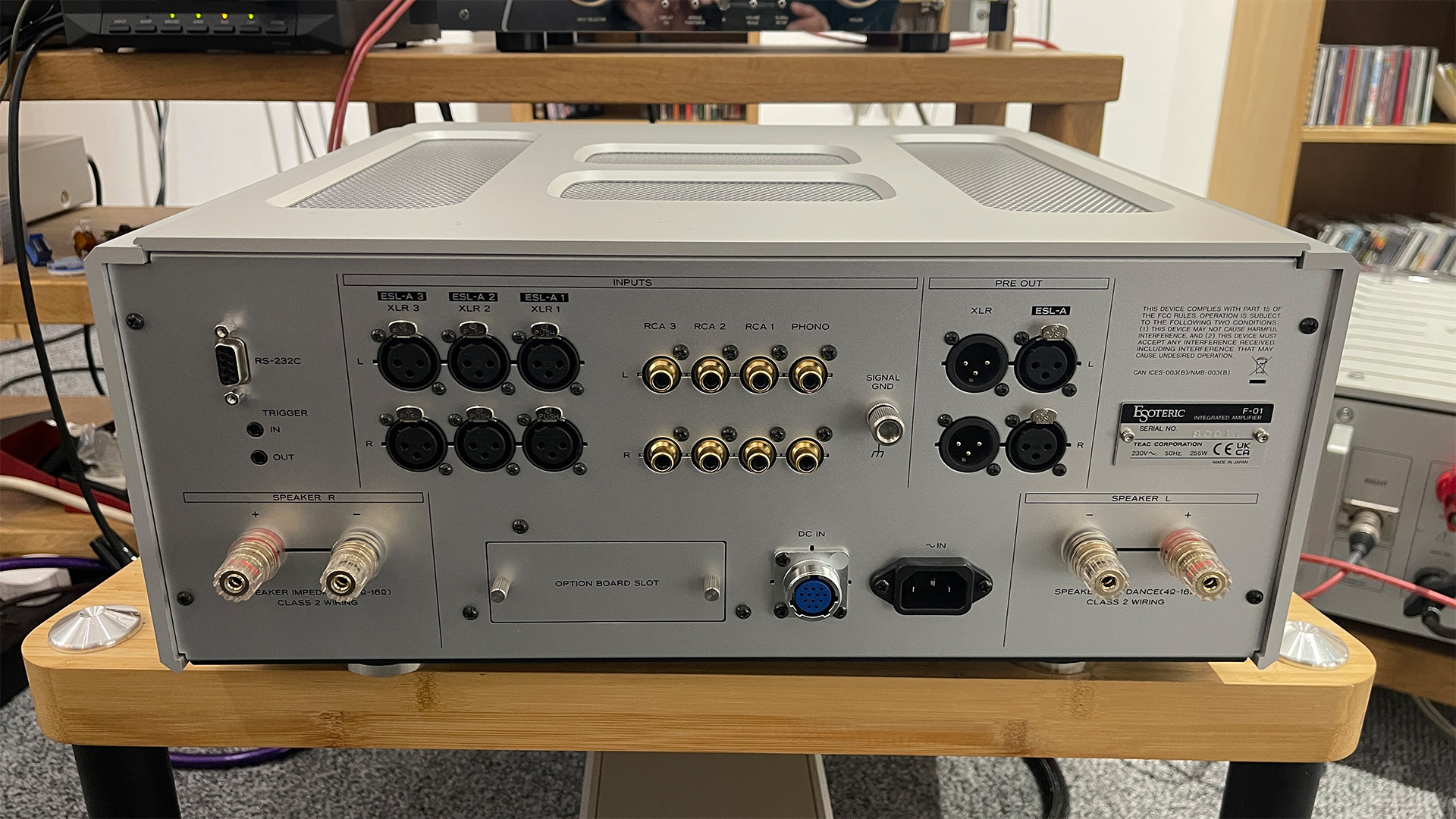
The F-01’s connectivity is good for a product of this type. Alongside the MM/MC phono stage there are six line-level inputs including three balanced XLRs. But there is a twist here with the option to configure the XLR inputs to ESL-A – a proprietary Esoteric signal connection that is current-based rather than voltage and is claimed to deliver clearer, more dynamic results. ESL-A only works with in-house sources, so has no use outside Esoteric’s electronic ecosystem.
There are two sets of preamp outputs – balanced XLR and ESL-A – along with a single pair of high-quality multi-way speaker terminals per channel. This amplifier is a pure analogue unit, so if you need digital inputs you will have to budget for an outboard DAC. Make sure that number cruncher is good though. Such is the transparency of the F-01 that anything that’s below par will be ruthlessly exposed. We would suggest that something the level of Chord’s excellent Hugo TT2 should be considered a decent starting point.
Compatibility
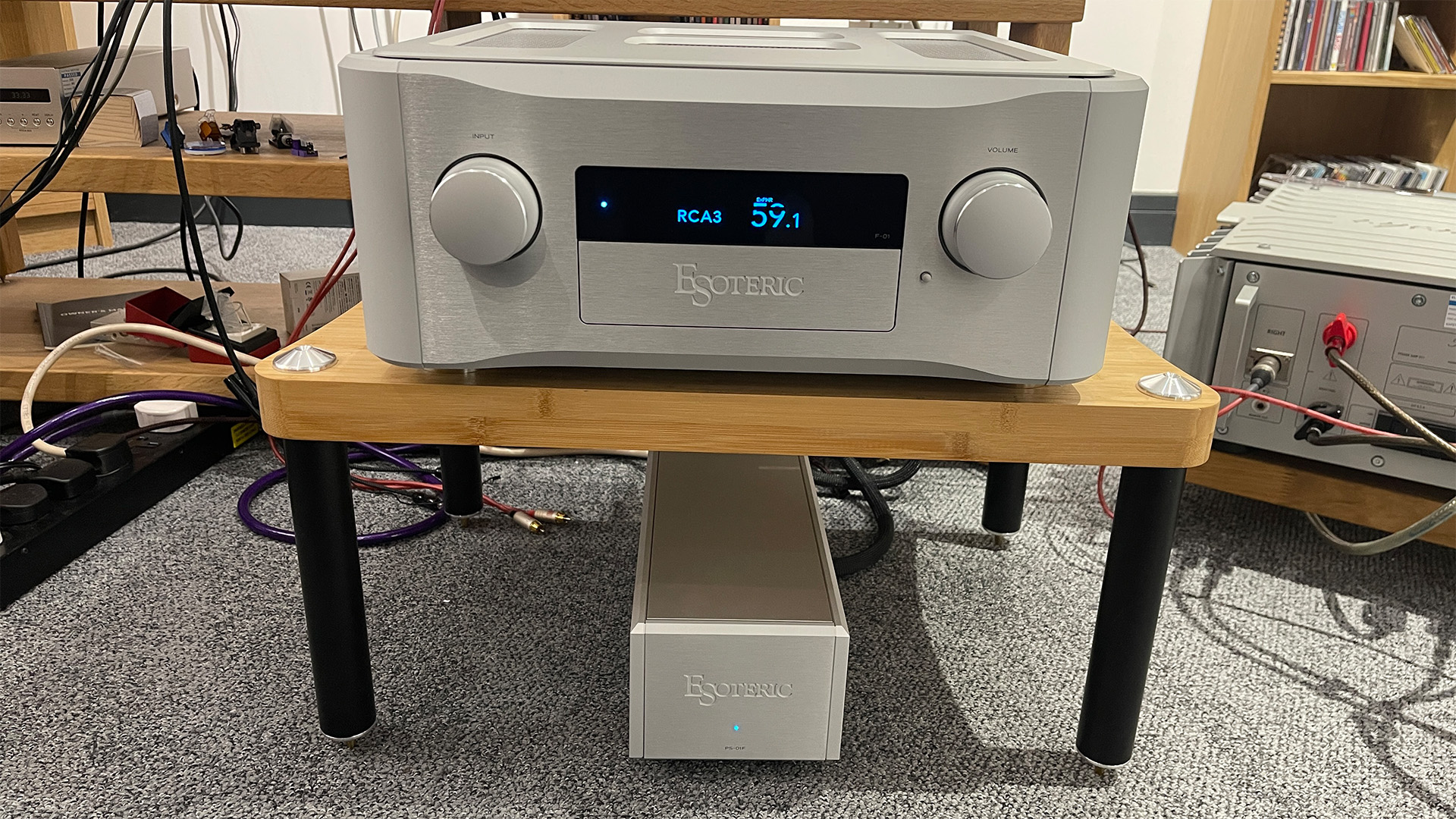
This Esoteric puts similar demands on the rest of the system. It is so clear and revealing that any shortcomings in the source are easily heard. This isn’t an amplifier that goes out of its way to highlight flaws elsewhere, but its innate honesty means that any problems upstream aren’t fudged.
Our reference sources, the Naim ND555/555 PS DR music streamer and Technics SL-1000R/Dark Sabre MM record player, work well, giving the Esoteric the kind of quality feed it deserves. We also have a Kiseki Purpleheart MC on hand to test the F-01’s moving coil input.
Things are a little more complicated when it comes to speakers. This integrated’s relatively low output means that it wouldn’t be our first choice to drive low-sensitivity speakers, particularly in large rooms or when very high volume levels are required. There are better options on the market for those particular jobs, and we suspect that’s the reason Esoteric goes to all the trouble of offering an alternative in the form of the similarly priced and closely related F-02 120-watt per channel Class A/B model.
Most of our listening is done at relatively modest levels, so we have no issue using our usual reference speakers, ATC’s SCM50 (85dB/W/m) and Wilson Benesch’s Discovery 3Zero (89dB/W/m), in our 3 x 7 x 5m (hwd) test room. Our comparison amplifier is the Burmester 088/911 Mk III pre/power combination, and we have only just reviewed Goldmund’s Telos 690 integrated amplifier (£32500 / $36250 / AU$60000), so the memories of it are still fresh.
Sound
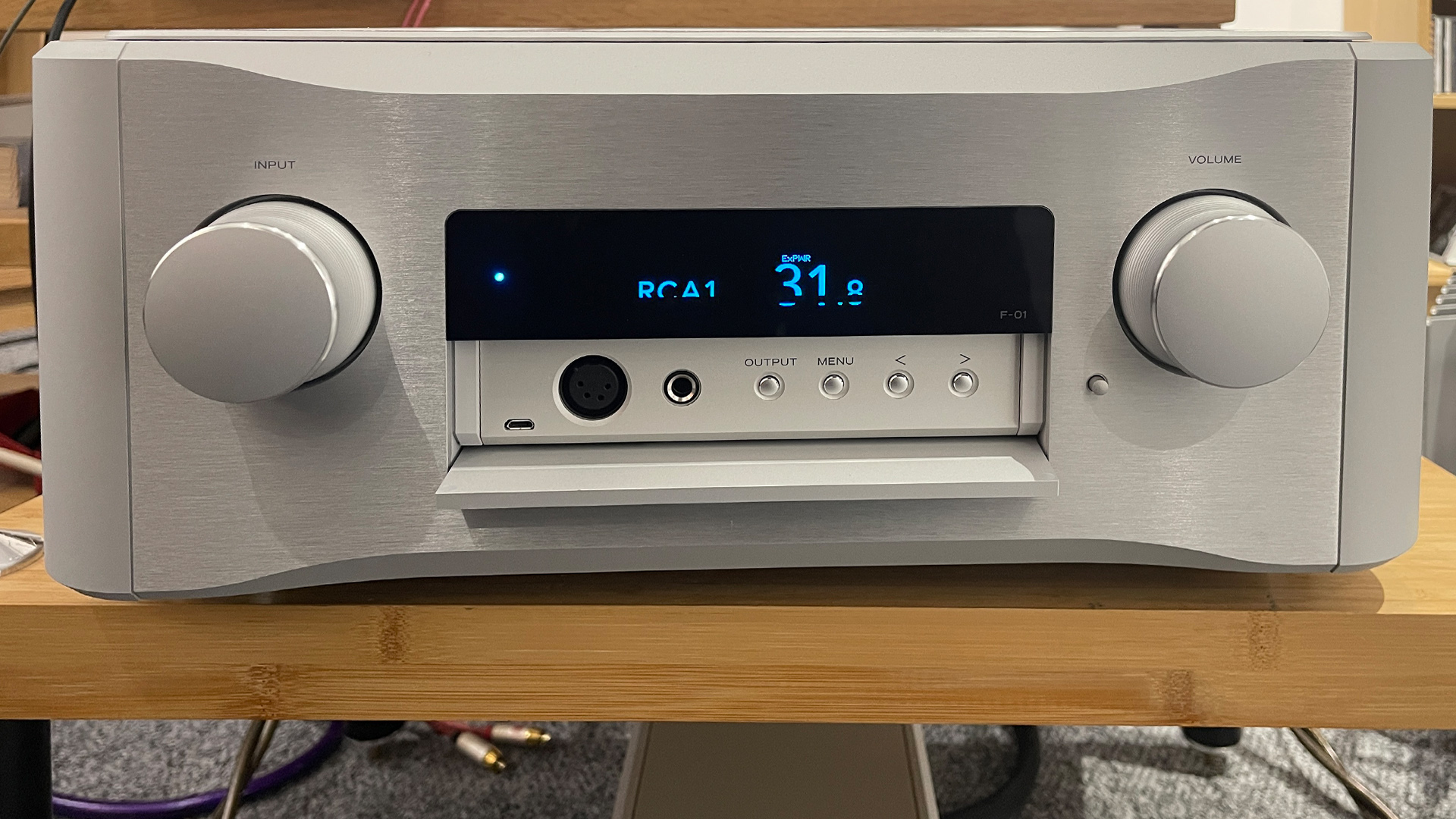
Our first task is to decide on the sonic value of the pricey optional PS-01F outboard supply. This is something that doesn’t take long to do. It takes just a few minutes to confirm that the power supply offers huge benefits across the board, from improving dynamic and detail levels to expanding the soundstage. Apart from the hefty price and the additional space it takes up on the equipment rack, there are no downsides here. The PS-01F should be considered an essential part of the F-01 package.
There are some things the F-01/PS-01F package just can’t do. Regardless of partnering speakers it simply doesn’t have the muscle to deliver large-scale dynamic shifts with the same conviction as our Burmester pairing (180 watts per channel). Similarly, if ultimate grip and punch at the lowest frequencies are paramount, there are others at this price level that do it better. The aforementioned Goldmund is a fine example of that.
Yet, despite these limitations, the Esoteric F-01/PS-01F is without doubt one of the finest amplifiers we have ever had in our test room. It sounds a little hard and cluttered on initial switch-on, lacking in space and tonal colour. But given the best part of a week to settle, the F-01’s sound blossoms. It becomes clearer and gains a degree of finesse that puts it among the top rung of integrated amplifiers currently made.
This is not a product that grabs the listener by the lapels and demands attention. It has a gentler disposition than that, captivating the listener with a presentation that marries exceptional detail resolution with refinement and dynamic fluidity better than almost anything else we’ve heard.
As we listen to Dave Brubeck’s Take Five it is impossible not to be taken in by the naturalness of the presentation; the way the F-01 captures the tone and texture of the various instruments in such a convincing way. Rarely do we hear hi-fi reproduce the famous drum solo in this piece so well, rendering the explosive nature of the instrument without overdoing things.
Not only does the amplifier capture the individual instruments superbly, but it also manages to bring everything together to produce a cohesive and musical whole. The sense of rhythmic drive lacks the hard-charging nature of the very best that Naim can manage at this level, but still comes through in a captivating manner that just carries us along. The lack of undue hard edges in the presentation puts us in mind of the finest valve-powered products we’ve heard from the likes of Audio Research and Nagra, but the Esoteric adds a lovely sense of understatement to the proceedings that bodes well for long-term satisfaction.
Stereo imaging is excellent with an expansive soundstage combined with top-class focus and stability. This Esoteric pairing layers the sound convincingly, delivering the depth aspect of a recording better than most we have heard. Pleasingly, instruments stay locked in position even when the music gets demanding.
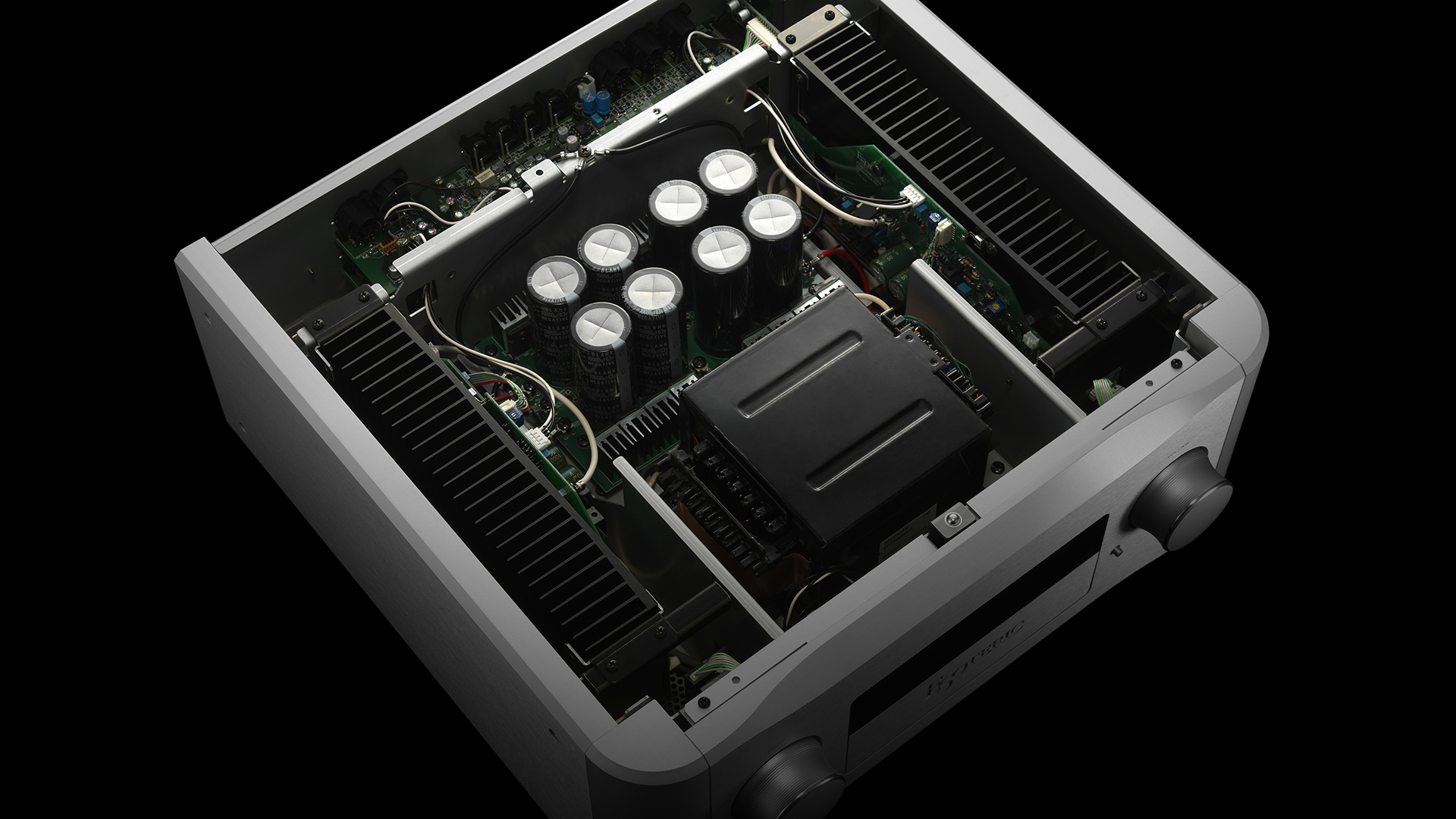
You would think that The F-01/PS-01F’s innate smoothness and natural warmth would take the edge off more aggressive music such as Massive Attack’s Heligoland, but that’s not the case. Provided the partnering system is chosen with care, the Esoteric has plenty of attitude, capturing the spirit of the album well. It can party when the music demands, showing plenty of verve with appropriate source material. When it comes to organisation and control, this amplifier is straight out of the top drawer; its ability to dig deep into a production is second to none in our experience.
We love this amplifier’s articulate nature. The lows are rich but well-defined, delivering a surprising amount of punch and power for such a modestly powered unit. There is a lovely natural warmth and palpability to vocals, and we have plenty of fun going through the various works of Nina Simone, Adele and Beyoncé. At the top end, the Esoteric is as sweet as you like without sounding rounded or dull.
The good news continues with the phono stage. Regardless of whether we use the Vertere Dark Sabre moving magnet or Kiseki’s Purpleheart MC, the result is a low level of background noise and a performance that mirrors the elegance, insight and expression of the line stages. However, if you are something of an obsessive, the lack of cartridge loading optimisation could be an issue with more demanding cartridges, so look to a more flexible outboard unit of at least Luxman’s EQ500 (£5499 / $6695 / AU$9999) level.
The story is similarly positive when we use the headphone outputs. There is a definite benefit in connecting to the 4-pin XLR balanced output if given the choice. We use our Focal Stellia with both the standard 6.3mm connector and 4-pin XLR, and find that the latter produces bolder and slightly clearer results. Regardless, both headphone outputs reflect the excellent sound we hear through our speakers, and that puts the F-01/PS-01F’s headphone amp section up with the best of the opposition.
Verdict

It should be clear by now that we have fallen for Esoteric’s F-01/PS-01F in a big way. Provided it is matched with care, this hefty integrated delivers one of the most alluring performances we have heard from an amplifier at this level. Yes, it is hugely expensive, but the rich strain of magic that flows through its circuitry is truly spellbinding.
SCORES
- Sound 5
- Build 5
- Features 5
MORE:
Read our review of the Goldmund Telos 690
Also consider Burmester's 088/911MkIII
Best stereo amplifiers: 9 class leaders chosen by our review experts

Ketan Bharadia is the Technical Editor of What Hi-Fi? He has been reviewing hi-fi, TV and home cinema equipment for almost three decades and has covered thousands of products over that time. Ketan works across the What Hi-Fi? brand including the website and magazine. His background is based in electronic and mechanical engineering.
- Andy Madden
- Kashfia KabirHi-Fi and Audio Editor
-
Friesiansam I can't help thinking, that a £22,000 amplifier's internal power circuitry should be good enough, to not need a £5,500 external psu, to get the best out of it.Reply
